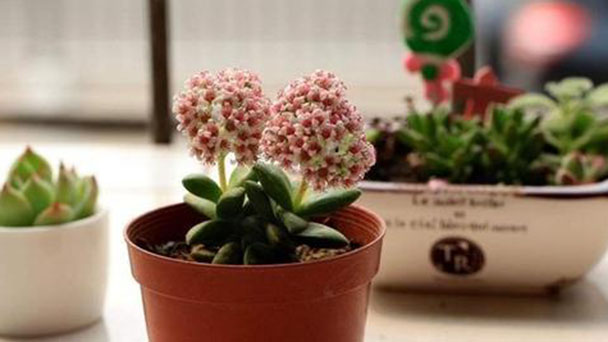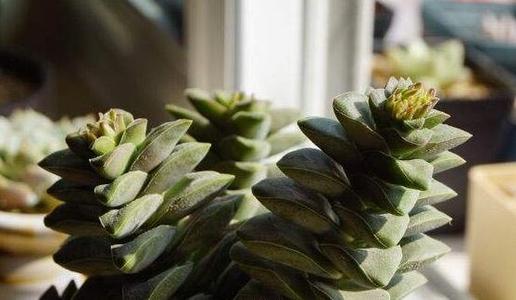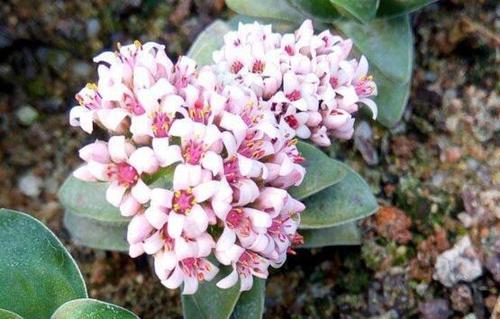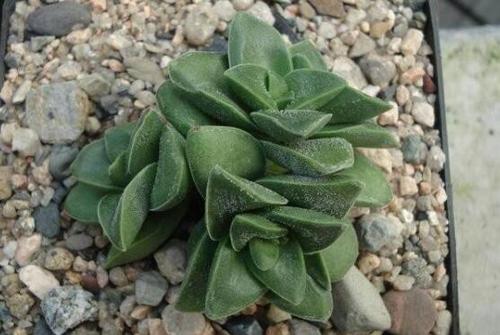Crassula Springtime profile
Written by Maggie
Feb 08 2021

Crassula Springtime is a relatively large succulent plant belonging to the genus Cyclosaurus and the family Chrysophoraceae. Crassula Springtime leaves are peculiar and triangular in shape; It is plump and thick leaf blade tip slightly narrower and slightly rounded; Its emerald green leaves intermingle into tiny plants; Crassula Springtime is delicate and lovely, elegant and chic; Crassula Springtime leaves are green like jade, crystal clear; It blossoms pink, every flowering, blossoming small flowers into clusters of large flower balls gathered top.
Crassula Springtime picture

Crassula Springtime habits
Crassula Springtime, prefers warm, dry and sunny environments, is resistant to drought and semi-shade, and does not tolerate cold.In addition to avoid scorching sun insolation when high temperature in midsummer, other seasons should give adequate illumination. Just pay attention to summer ventilation and shade, remember warm fear of moisture on the line. crassula springtime is dormant in winter and is not cold resistant. Please pay attention to keep warm.
Crassula Springtime morphological characteristics
Crassula Springtime leaves are pale grayish green to dark green, triangular at the front and densely opposite in pairs. The flowers bloom in spring. The flowers are clustered at the top and pink. Crassula Springtime are abundant and fragrant, thus attracting pests such as aphids and scale insects during the flowering season
Crassula Springtime growing method
1. The sunshine
Generally in the spring and summer, it is the best time for Crassula Springtime growth, at this time we can let it have the whole day of sunlight, let it enjoy more sunshine, and promote its growth. But usually in the summer Crassula Springtime goes slightly dormant, so if we want it to bloom, we need more sun exposure at this time to make it bloom faster. In winter, the light is relatively weak. At this time, we can choose a place with as much sunshine as possible for the whole day.
2. Water
On watering Crassula Springtime, we must pay attention to if it has been a long time without water has dried up, that this time must remember when water also want to give it to soak, like this can satisfy its roots to the amount of water, but if not then we don't need to water the on it, as long as keep it of the soil is wet, but not too wet. Water about once or twice a week during the Crassula Springtime growing season. Summer watering should pay attention to in summer when the temperature is high must pay attention to the amount of watering, generally every month on it 3 to 4 times of water, but also a small amount of water in its basin, this is to see their own basin size and local weather conditions to give. This will help maintain the root system and prevent Crassula Springtime from becoming too dry and dry. In the winter, if the temperature is below 5 degrees, it is necessary to begin to slowly cut off the water, and it is necessary to keep the basin soil dry below 3 degrees.In this way, we can survive the winter safely.
3. The soil
Crassula Springtime is picking up the soil, must choose the permeability is good, a bit peat soil mixed coal cinder is commonly used in line, like this can be very good it was isolated from the surface of soil and plant, make permeability is good, of course, when selecting a soil also want to choose the better drainage, prevent the presence of water.

Crassula Springtime method of propagation
Seed propagation
For large areas of Crassula Springtime propagation, the seeds of Crassula Springtime can be sown on a prepared bed and then covered with a thin layer of soil to keep warm and moist.By keeping the temperature at 21°C, Crassula Springtime seeds will germinate in about a week.
Cutting propagation
There are many methods for Crassula Springtime cutting propagation. One is leaf cutting, that is, using fleshy leaves of Crassula Springtime for cutting, which is more convenient but has a low survival rate. The other is root planting, which intercepts fleshy bits of Crassula Springtime rhizomes with buds and buries them in the soil, so that new plants will grow from the bud points on the roots. The third method is the cutting method. The upper part of the fleshy part of Crassula Springtime is cut down, leaving the rhizome to continue growing, and the cut part is used for cutting propagation. As for splitting propagation, it means that after the Crassula Springtime grows fleshy to a certain extent, some small plants will grow in groups. These small plants with roots can be taken out from the soil and then moved to a new pot for planting. Due to the existence of roots, they will generally adapt and grow in about a week.
Common pest control of Crassula Springtime
Aphids/scale insects
Crassula springtime succulent is generally free of obvious disease, only attracting aphids and scale insects during the flowering season. If the insect pest is less, can be artificially captured, can use a soft brush to kill the insect pest.
Anthrax
This disease is caused by the Crassula Springtime is too dense and poor ventilation, the main part of the disease in the plant stem and stem node, there will be some pale brown spots, if not timely treatment spots will expand. We need to cut off the plant in time, and then use anthrax Fu Mei and other special agents for prevention and control.

Latest Updated
- Benefits of Bugleweed - 7 Science-backed Health Benefits
- Bugleweed Dangers & Side Effects - Is It Poisonous?
- How to Plant Evergreen Trees - What You Should Know
- When to Plant Evergreens - Grow Guide for Evergreen Trees
- 12 Wonderful Evergreen Shrubs for Your Garden
- 12 Popular Evergreen Plants with Pictures for Beginners
- When And How To Prune A Lilac Bush Like a Pro
- How to Grow & Care for Lilac Vine (Hardenbergia Violacea)
- Japanese Lilac Tree (Syringa Reticulata) Care & Propagation Guide
- Shumard Oak Pros and Cons - What to Know
Popular Articles
- Winter maintenance of Antirrhinum Majus
- How to Grow Terminalia Mantaly Tree
- How to Grow and Care for Crossostephium Chinense
- How to grow Antirrhinum Majus in spring
- Peristeria Elata (Dove Orchid) Profile: Info & Care Guide
- Underwatered Snake Plant (Sansevieria Trifasciata) - Signs And How To Fix
- How to Care for Brazilian Jasmine Plant (Mandevilla Sanderi)
- How to Grow & Care for Graptopetalum Purple Delight in Summer
- Rosa Chinensis (China Rose): Plant Growing & Care Tips
- How to Care for Baby Sun Rose (Aptenia Cordifolia)